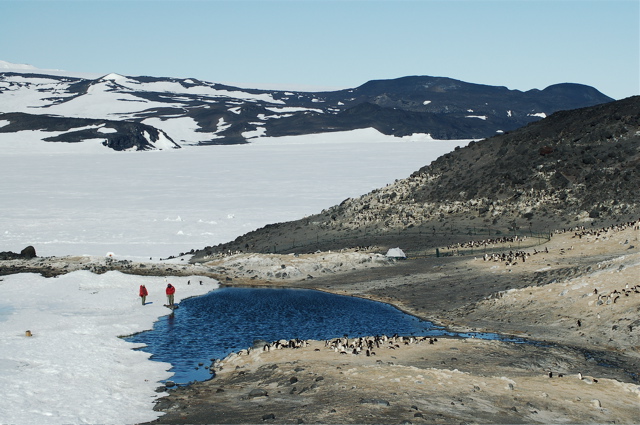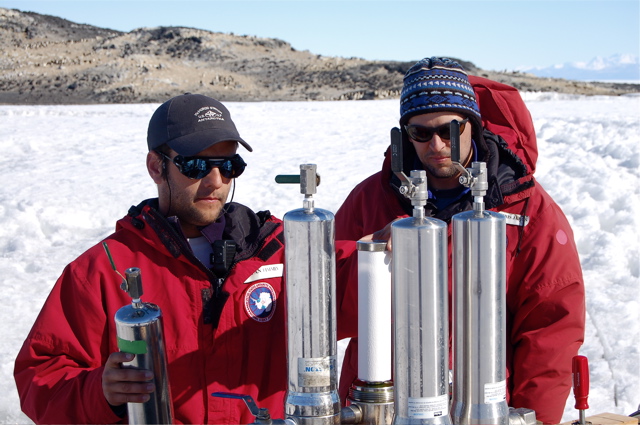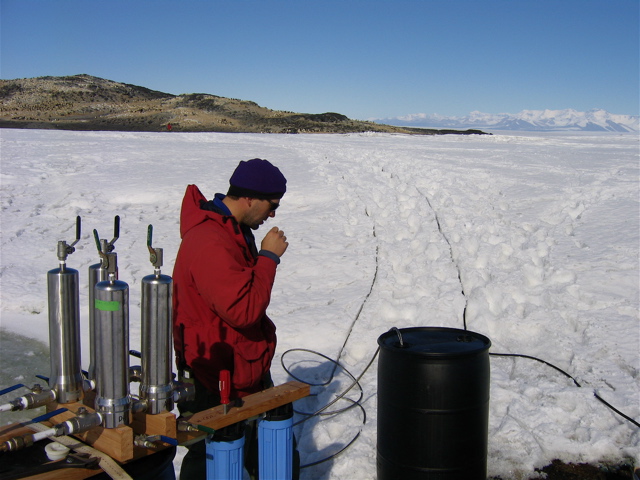( Log In ) Log In is for TREC Teachers & Researchers only
  |
| Dena_Rosenberger |
 Jan 10 2006, 01:29 PM Jan 10 2006, 01:29 PM
Post
#1
|
 TREC Teacher    Group: TREC Team Posts: 96 Joined: 1-November 05 Member No.: 22 |
Pony Lake Camp!
January 6, 2006 For those interested in things Antarctic and some fine journalism, check out the weekly Antarctic newspaper at http://AntarcticSun.usap.gov Hello from the Ice! For additional Antarctic pics, check out the Gallery. Where’s Rosenberger? Pony Lake, Ross Island, Antarctica A few days ago, we set up our field camp with our water pumping equipment and tents. After the helicopter dropped us off, Chris, Ryan, Markus, Kaelin, and I hauled stuff all over the Pony Lake area. > Kaelin and I in the helo. Thumbs up!  > Are you leaving us alone out here??  > Getting ready for Pony Lake chemistry:  The tents, food, and sleeping bags go a short walk over a hill from the penguin rookery. The pumps and cables get carried down to the lake edge (remember, we can’t use the generator anywhere near the penguins).  Another, quieter pump gets placed by the open water section of the lake in preparation for pumping water out. The empty 55-gallon drums are moved closer to the helo pad, away from the rookery.  Back at the campsite, the main cook tent is set up first (I am glad we set this up for practice at the Field Center building in McMurdo), then the storage and waste tent, then our small sleeping tents.   Next to set up is the pumping equipment. One small quiet pump is placed near the open water area next to the rookery (penguin chicks must get their sleep!). This pump will suck the water out and push it 350 feet across the frozen lake to the next pumping station, where the loud, gas-powered generator sits.  > Hmmmm...what's this?  At this station, the lake water will be coarse-filtered to get out the big algae and particles that we don’t want (they call this a “prefilter”). Next, the lake water is forced through two smaller filters called “Balston” filters that take out very tiny particles that are smaller than algae cells. We don’t want ANY of these things. What we want to collect is one of the things that passes through all of this, the Dissolved Organic Carbon, or DOC. Back in the lab in McMurdo, we will have to separate the different parts of the DOC to get the one specific part of it that these scientists want: fulvic acid (more on this later).  One thing that happens in the field is that you can’t plan for everything even though you try. Then, you have to make do with what you have and try to come up with a solution to your problem. This is one of the aspects of field science that I really like. It’s real problem solving with serious consequences if you can’t get something to work. Anyway, when we tried to run the Balston filters, they kept breaking. What we realized was that they were put together incorrectly and had to be reset and changed around. This took several hours of figuring things out. Once the water passes through these filters, it is collected in another 55-gallon drum and a submersible pump set inside the drum will pump the filtered water out.  Meanwhile, more tubing (800 feet!) was laid down, up the hill behind the lake and over a ridge to the empty drums near the helo pad. When they are full, these drums will weigh about 400 pounds each. As we fill up the drums with the super-filtered water, they are placed in a net with a hook called a “sling load” to be attached to the bottom of a helicopter for airlift back to McMurdo Station where they will be further filtered and processed by Kaelin. Kaelin and I spent an entire day rinsing out these 40 drums with distilled water, then Markus and I flew home.  One really cool thing was that our really cool pilot Barry actually set the helo down on top of the 300 foot high Barnes Glacier! Wow! Our helo pilot, Barry:  The Barnes Glacier from above:  > The Barnes Glacier up close and personal:  Did you know? Adelie penguins are curious critters! Current Conditions at McMurdo Station I have no idea because I am not there! |
  |
1 User(s) are reading this topic (1 Guests and 0 Anonymous Users)
0 Members:

|
NSF Acknowledgment & Disclaimer | Time is now: 1st November 2024 - 12:40 AM |
Invision Power Board
v2.1.7 © 2024 IPS, Inc.








